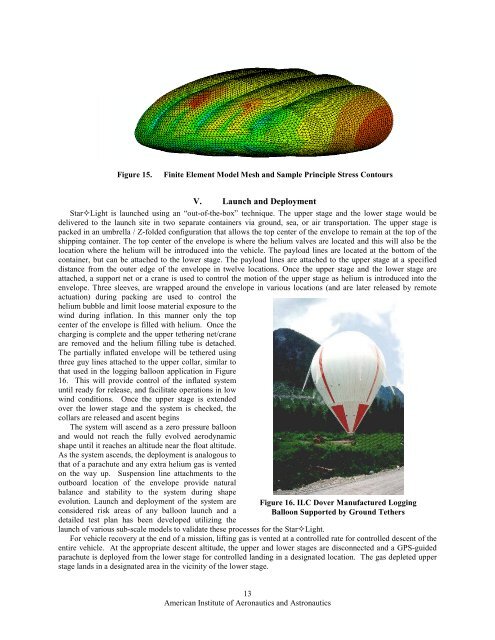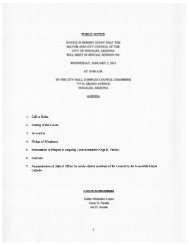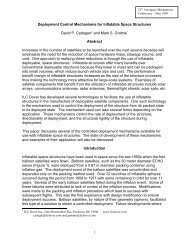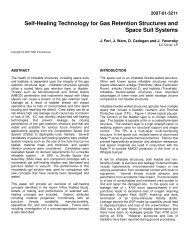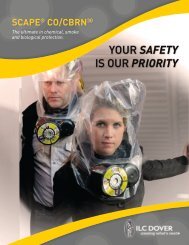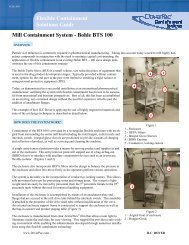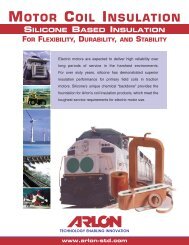A Novel Concept for Stratospheric Communications ... - Team-Logic
A Novel Concept for Stratospheric Communications ... - Team-Logic
A Novel Concept for Stratospheric Communications ... - Team-Logic
You also want an ePaper? Increase the reach of your titles
YUMPU automatically turns print PDFs into web optimized ePapers that Google loves.
Figure 15.Finite Element Model Mesh and Sample Principle Stress ContoursV. Launch and DeploymentStarLight is launched using an “out-of-the-box” technique. The upper stage and the lower stage would bedelivered to the launch site in two separate containers via ground, sea, or air transportation. The upper stage ispacked in an umbrella / Z-folded configuration that allows the top center of the envelope to remain at the top of theshipping container. The top center of the envelope is where the helium valves are located and this will also be thelocation where the helium will be introduced into the vehicle. The payload lines are located at the bottom of thecontainer, but can be attached to the lower stage. The payload lines are attached to the upper stage at a specifieddistance from the outer edge of the envelope in twelve locations. Once the upper stage and the lower stage areattached, a support net or a crane is used to control the motion of the upper stage as helium is introduced into theenvelope. Three sleeves, are wrapped around the envelope in various locations (and are later released by remoteactuation) during packing are used to control thehelium bubble and limit loose material exposure to thewind during inflation. In this manner only the topcenter of the envelope is filled with helium. Once thecharging is complete and the upper tethering net/craneare removed and the helium filling tube is detached.The partially inflated envelope will be tethered usingthree guy lines attached to the upper collar, similar tothat used in the logging balloon application in Figure16. This will provide control of the inflated systemuntil ready <strong>for</strong> release, and facilitate operations in lowwind conditions. Once the upper stage is extendedover the lower stage and the system is checked, thecollars are released and ascent beginsThe system will ascend as a zero pressure balloonand would not reach the fully evolved aerodynamicshape until it reaches an altitude near the float altitude.As the system ascends, the deployment is analogous tothat of a parachute and any extra helium gas is ventedon the way up. Suspension line attachments to theoutboard location of the envelope provide naturalbalance and stability to the system during shapeevolution. Launch and deployment of the system areconsidered risk areas of any balloon launch and adetailed test plan has been developed utilizing thelaunch of various sub-scale models to validate these processes <strong>for</strong> the StarLight.Figure 16. ILC Dover Manufactured LoggingBalloon Supported by Ground TethersFor vehicle recovery at the end of a mission, lifting gas is vented at a controlled rate <strong>for</strong> controlled descent of theentire vehicle. At the appropriate descent altitude, the upper and lower stages are disconnected and a GPS-guidedparachute is deployed from the lower stage <strong>for</strong> controlled landing in a designated location. The gas depleted upperstage lands in a designated area in the vicinity of the lower stage.13American Institute of Aeronautics and Astronautics


